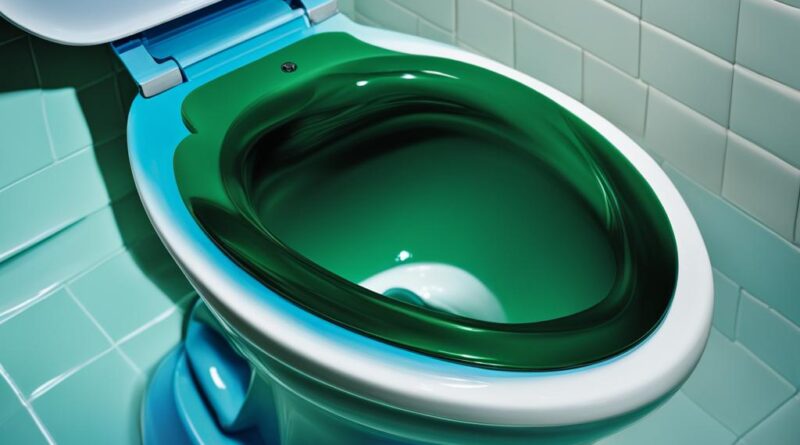Why Does My Toilet Whistle? Understanding the Problem
Do you ever wonder why your toilet makes a high-pitched whistling noise after flushing? This unsettling sound is actually an indication that your toilet is in need of repair. The most common cause of a whistling toilet is a faulty fill valve, which can deteriorate over time. Another culprit could be a faulty gasket in toilets with a ballcock. It’s important not to ignore this issue, as it can potentially lead to an overflowing toilet. The good news is that most modern toilets have affordable, plastic valves that can be easily replaced.
Key Takeaways:
- A whistling toilet is a sign of a problem and should not be ignored.
- The most common cause is a faulty fill valve or a damaged gasket in a ballcock.
- Ignoring the issue can lead to an overflowing toilet and water damage.
- Replacing the fill valve is the most common fix for a whistling toilet.
- If DIY repairs are not successful, it is advisable to consult a professional plumber.
Common Causes of a Whistling Toilet
A whistling toilet can be a frustrating problem to deal with, but understanding the common causes can help you troubleshoot and resolve the issue. Here are some reasons why your toilet may be whistling:
- Deteriorated Fill Valve: One of the most common causes of a whistling toilet is a deteriorated or faulty fill valve. Over time, the plastic components of the fill valve can degrade, resulting in vibrations and the whistling sound.
- Malfunctioning Gasket: In toilets with a ballcock mechanism, a faulty gasket can also cause whistling. If the gasket is damaged or worn out, it may not seal properly, leading to vibrations and the whistling noise.
- Water Pressure: High water pressure can sometimes contribute to a whistling toilet. When the water rushes into the tank too forcefully, it can create turbulence and cause the whistling sound.
To troubleshoot the issue, start by inspecting the fill valve and gasket for any signs of damage or wear. If you notice any issues, replacing these components can often resolve the whistling problem. Additionally, consider checking the water pressure in your home and adjusting it if necessary.
Table: Common Causes of a Whistling Toilet
| Causes | Description |
|---|---|
| Deteriorated Fill Valve | The plastic components of the fill valve wear out over time, causing vibrations and whistling. |
| Malfunctioning Gasket | A damaged or worn-out gasket in the ballcock mechanism can lead to improper sealing and whistling. |
| Water Pressure | High water pressure can create turbulence in the tank, resulting in whistling. |
By addressing these common causes, you can effectively troubleshoot and resolve a whistling toilet. However, if the issue persists or you’re unsure about how to fix it, it’s always recommended to seek the assistance of a professional plumber. They have the expertise to diagnose and repair any underlying issues, ensuring your toilet operates smoothly and quietly.
Professional Fixes for a Whistling Toilet
If you’re experiencing a whistling noise coming from your toilet, there are several professional fixes that can help resolve the issue. While some homeowners may be able to tackle the problem themselves, it’s always a good idea to seek the assistance of a professional plumber if you’re unsure or if the problem persists.
Replacing the Fill Valve
One of the most common fixes for a whistling toilet is to replace the fill valve. The fill valve is responsible for regulating the water level in the toilet tank after each flush. Over time, the valve can deteriorate and cause the whistling sound. To replace the fill valve, start by shutting off the water supply and emptying the tank. Unscrew the old fill valve from the bottom of the tank and install a new one. Adjust the new fill valve to the appropriate level and secure it in place. This simple fix can often eliminate the whistling sound and restore proper functioning to your toilet.
Consulting a Professional Plumber
If replacing the fill valve doesn’t resolve the issue or if you’re unsure about how to proceed, it’s best to consult a professional plumber. They have the knowledge and expertise to diagnose any underlying issues causing the whistling and can provide expert solutions. A professional plumber will ensure that the problem is resolved correctly and can help prevent any future issues with your toilet.
Summary
If your toilet is whistling after flushing, it’s important to address the issue promptly to prevent further damage. While replacing the fill valve is a common fix that can often be done by homeowners, it’s recommended to seek the assistance of a professional plumber if you’re unsure or if the problem persists. A professional plumber can diagnose the cause of the whistling and provide expert solutions, ensuring that your toilet is properly repaired and functioning as it should.
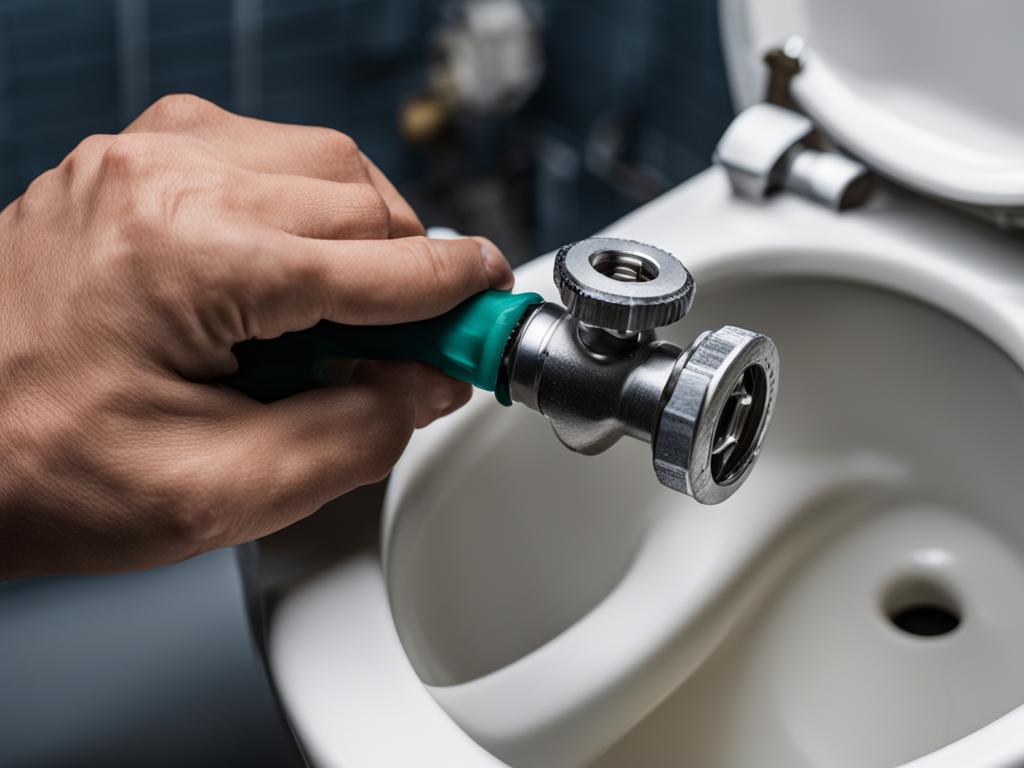
Prevention Tips to Silence Your Toilet’s Whistle
To prevent a whistling toilet, it’s important to perform regular maintenance and take preventive measures. Here are some useful tips to stop your toilet from whistling:
- Keep the fill valve clean: Regularly inspect and clean the fill valve to prevent debris buildup. Use a soft cloth or sponge to wipe away any dirt or sediment that may interfere with the valve’s proper functioning.
- Replace the gasket: The gasket inside the fill valve can wear out over time, leading to a whistling sound. Consider replacing the gasket periodically, especially if you notice any signs of deterioration or leakage.
- Consider a plastic valve: If your toilet has a metal ballcock valve, it may be more prone to causing whistling noises. Consider replacing it with a plastic valve, as plastic valves are less likely to produce vibrations and result in whistling sounds.
“Regular maintenance and preventive measures can help keep your toilet in good working order and prevent whistling noises.”
By following these prevention tips, you can reduce the likelihood of a whistling toilet and ensure the smooth functioning of your bathroom fixtures.
| Prevention Tips | Description |
|---|---|
| Keep the fill valve clean | Regularly inspect and clean the fill valve to prevent debris buildup and vibrations. |
| Replace the gasket | Periodically replace the gasket inside the fill valve to maintain a proper seal and prevent whistling. |
| Consider a plastic valve | If you have a metal ballcock valve, consider replacing it with a plastic valve to minimize vibrations and whistling noises. |
Remember, taking proactive measures can save you from the inconvenience and potential damage caused by a whistling toilet. By keeping your toilet well-maintained, you can ensure a peaceful and functional bathroom experience.
Don’t Ignore a Whistling Toilet
If your toilet is making a whistling noise after flushing, it is important not to ignore the issue. While it may seem like a minor inconvenience, a whistling toilet can indicate an underlying problem that needs to be addressed. Ignoring the problem can lead to further damage and potential water leakage, resulting in costly repairs.
One of the most common causes of a whistling toilet is a faulty fill valve. Over time, the fill valve can deteriorate, leading to vibrations and the whistling sound. Other potential causes include a faulty gasket in the ballcock valve or debris buildup in the fill valve. These issues can disrupt the proper functioning of the toilet and should be resolved promptly.
To prevent further damage and ensure the proper functioning of your toilet, it is recommended to take action when you notice a whistling sound. You can start by checking the water supply valve and ensuring it is fully open. If the whistling persists, it may be necessary to replace the fill valve or contact a professional plumber for assistance. Promptly addressing the issue will help prevent potential water damage and maintain the efficiency of your toilet.
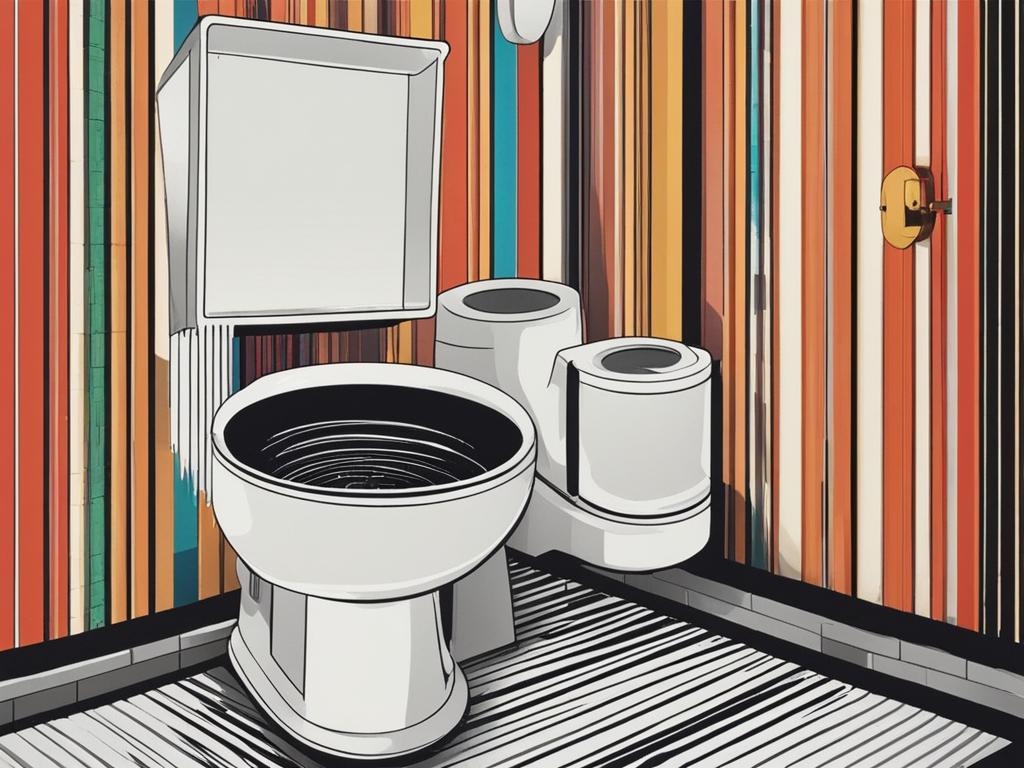
Expert Plumbing Services for Whistling Toilet Issues
If you’ve attempted DIY repairs for your whistling toilet and the problem persists, it’s time to seek the assistance of a professional plumber. They are equipped with the knowledge and expertise to diagnose the underlying causes of the whistling and provide effective solutions.
Professional plumbers have access to a wide range of tools and replacement parts, ensuring that your whistling toilet can be repaired correctly. They can identify if the fill valve needs to be replaced or if there are other issues contributing to the whistling sound.
Hiring a professional plumber not only ensures that the problem is resolved, but it also helps prevent future issues with your toilet. They can provide expert advice on how to maintain and care for your toilet to prevent whistling and other plumbing problems in the future.
| Benefits of Professional Plumbing Services for Whistling Toilet Issues |
|---|
| Expertise in diagnosing and repairing toilet issues |
| Access to specialized tools and replacement parts |
| Prevention of future toilet problems |
When to Call a Professional Plumber
If you’re unsure of how to fix a whistling toilet or if your attempted repairs haven’t resolved the issue, it’s best to call a professional plumber. Here are some signs that indicate it’s time to seek expert assistance:
- The whistling sound persists despite your DIY repairs
- You’re uncertain about how to diagnose or fix the underlying issue
- You want to ensure the problem is resolved correctly to prevent further damage
Don’t hesitate to contact a professional plumber to ensure that your whistling toilet is properly repaired.
Understanding the Functioning of a Toilet Fill Valve
The toilet fill valve plays a crucial role in maintaining the water level in the toilet tank after each flush. It is responsible for allowing water to enter the tank when the level is low and shutting off the flow when the desired level is reached. Understanding how this valve works can help diagnose and fix issues such as a whistling toilet.
The fill valve consists of a float and a valve mechanism. When the tank is empty or the water level is low, the float drops, signaling the valve to open. This allows water to flow into the tank from the water supply line. As the water level rises, the float also rises, eventually reaching a point where it signals the valve to close, stopping the water flow.
The whistling sound in a toilet can occur when the fill valve is not functioning properly. If the valve deteriorates or there is an issue with the gasket, it may not close completely, causing water to continue flowing and creating vibrations that result in a high-pitched whistle. In some cases, replacing the fill valve or installing a new gasket can eliminate the whistling noise and restore proper operation of the toilet.
| Function | How it Works |
|---|---|
| Water Entry | The fill valve opens when the water level is low, allowing water to flow into the tank. |
| Water Shut-off | As the water level rises, the float rises and signals the valve to close, stopping the water flow. |
| Whistling Noise | If the fill valve is faulty, it may not close completely, leading to water flow and vibrations that cause a whistling sound. |
If your toilet is making a whistling noise, it is important to address the issue promptly. Ignoring the problem can lead to further damage and potential water overflow. Understanding the functioning of the toilet fill valve can help you diagnose and fix the issue or seek professional assistance if needed.
Causes of Toilet Whistling After Flushing
When your toilet whistles after flushing, it can be an annoying and concerning problem. Understanding the causes of this whistling can help you identify the issue and take appropriate action. The most common cause of a whistling toilet after flushing is a deteriorated fill valve. Over time, the parts of the fill valve can wear out or become damaged, resulting in the whistling sound.
Another possible cause of a whistling toilet is a faulty gasket in a ballcock valve. The gasket can deteriorate over time or become misaligned, leading to vibrations and the subsequent whistling noise. If you notice your toilet whistling after flushing, it is important to address the issue promptly to prevent further damage or potential flooding.
Replacing the fill valve is usually the most effective solution for a whistling toilet after flushing. This can be done by disconnecting the water supply, emptying the tank, and unscrewing the old fill valve. Once the old valve is removed, you can install a new one and adjust it to the appropriate level. If you are unsure how to replace the fill valve or if the problem persists after replacement, it is recommended to contact a professional plumber for assistance.
| Causes of Toilet Whistling After Flushing |
|---|
| A deteriorated fill valve |
| A faulty gasket in a ballcock valve |
By addressing the causes of a whistling toilet after flushing, you can restore peace and quiet to your bathroom. Regular maintenance and prompt repairs can help prevent further issues and ensure the proper functioning of your toilet. If you are unsure about how to fix the problem or if DIY attempts are unsuccessful, it is always best to seek the expertise of a professional plumber for a thorough inspection and appropriate solutions.

Troubleshooting a Whistling Toilet
If your toilet is making a whistling sound, it can be frustrating and disruptive. Fortunately, there are several troubleshooting steps you can take to identify and resolve the issue. By following these steps, you can silence your toilet’s whistle and restore peace and quiet to your bathroom.
Step 1: Check the Water Supply Valve
The first step in troubleshooting a whistling toilet is to check the water supply valve. Ensure that it is fully open and allowing water to flow freely into the tank. Sometimes, a partially closed water supply valve can cause the fill valve to vibrate, resulting in the whistling sound.
Step 2: Inspect and Clean the Fill Valve
If the whistling persists after checking the water supply valve, the next step is to inspect and clean the fill valve. Remove the toilet tank’s cover and locate the fill valve. Look for any debris or deposits that may be causing the whistling. Use a damp rag to clean off any buildup and ensure that the fill valve is free from obstructions.
Step 3: Replace the Fill Valve
If cleaning the fill valve does not resolve the whistling issue, it may be necessary to replace the fill valve entirely. Over time, fill valves can deteriorate and lose their ability to properly control water flow, leading to whistling noises. Consult the manufacturer’s instructions or seek professional assistance to ensure that you properly install a new fill valve.
Remember, troubleshooting a whistling toilet requires patience and careful attention to detail. By following these steps, you can identify the cause of the whistling and take appropriate action to fix the issue. If you’re unsure or uncomfortable with performing these troubleshooting steps yourself, don’t hesitate to contact a professional plumber for assistance.
Fixing a Whistling Toilet Yourself
If you’re dealing with a whistling toilet and want to address the issue yourself, it’s important to follow the proper steps. By replacing the fill valve, you can eliminate the whistling sound and restore your toilet’s normal functioning. Here’s a simple guide to fix a whistling toilet:
- Start by shutting off the water supply to the toilet. Look for the water shut-off valve, usually located behind or near the toilet.
- Flush the toilet to drain the water from the tank completely.
- Once the tank is empty, unscrew the old fill valve from the bottom of the tank. Use a wrench or pliers if necessary.
- Install the new fill valve by screwing it into place at the bottom of the tank. Make sure it is securely tightened.
- Adjust the new fill valve to the appropriate water level. Follow the manufacturer’s instructions for specific guidance.
- Turn the water supply back on and allow the tank to fill up. Check for any leaks around the fill valve.
- Finally, flush the toilet to ensure the whistling sound is gone and that the toilet is functioning properly.
By following these steps, you can successfully fix a whistling toilet and avoid the need for professional assistance. Remember to always shut off the water supply before making any repairs and to carefully follow the instructions provided by the manufacturer of the new fill valve.
If you’re uncertain about tackling the repair yourself or if the whistling persists after replacing the fill valve, it’s a good idea to contact a professional plumber. They have the expertise and knowledge to diagnose and address any underlying issues that may be causing the whistling sound. Hiring a professional ensures that the problem is resolved correctly and can save you from potential future complications with your toilet.
Table: Comparison of DIY Repair and Professional Plumbing Services
When it comes to fixing a whistling toilet, you have the option to either address the issue yourself or hire a professional plumber. Here’s a comparison of the two approaches:
| DIY Repair | Professional Plumbing Services | |
|---|---|---|
| Skills Required | Basic plumbing knowledge | Professional training and experience |
| Cost | Lower, only the cost of replacement parts | Higher, including labor and expertise |
| Time | Short, depending on your experience | Relatively quick, as professionals are efficient |
| Results | Satisfactory if done correctly | Assured, as professionals guarantee their work |
| Additional Issues | Possible if underlying problems are not addressed | Identified and resolved |
Consider your own skills, time availability, and comfort level with plumbing repairs when deciding whether to fix a whistling toilet yourself or hire a professional. Both options can lead to a resolution, but professional services may provide greater peace of mind and ensure a thorough evaluation of your toilet’s functioning.
Importance of Promptly Addressing a Whistling Toilet
A whistling toilet may seem like a minor annoyance, but it should not be ignored. Addressing the issue promptly is crucial to prevent further damage and ensure the proper functioning of your toilet. When a toilet whistles, it is often a sign of an underlying problem that can worsen over time. By taking prompt action, you can avoid higher water usage, increased utility bills, and even potential damage caused by an overflowing toilet.
Ignoring a whistling toilet can lead to significant water damage in your bathroom and home. The whistling sound is a clear indication that something is wrong, usually with the toilet fill valve or gasket. These components can deteriorate over time, causing vibrations and resulting in the high-pitched noise.
To prevent further damage, it is recommended to address the issue as soon as you notice your toilet whistling. Fortunately, fixing a whistling toilet is often a relatively simple task that can be done by homeowners. However, if you are unsure of how to fix it or if the problem persists after attempting DIY repairs, it is advisable to seek professional plumbing services.
| Reasons to Promptly Address a Whistling Toilet |
|---|
| Gains attention |
| Prevents water damage |
| Avoids higher utility bills |
| Prevents an overflowing toilet |
Professionals have the expertise and experience to diagnose the cause of the whistling and provide appropriate solutions. They can efficiently repair or replace the faulty components, ensuring that your toilet operates smoothly and quietly once again.
By promptly addressing a whistling toilet, you can protect your home from potential water damage and avoid the inconvenience of a malfunctioning toilet. Don’t hesitate to take action and contact a professional plumber if needed. Remember, a small repair now can save you from more significant issues down the line.
Professional Plumbing Services to Stop Toilet Whistling
If DIY repairs and troubleshooting steps have not resolved the whistling issue in your toilet, it is highly recommended to seek the services of a professional plumber. Professional plumbers have the expertise and experience to accurately diagnose the cause of the whistling and provide effective solutions to fix the problem.
When you hire a professional plumber for toilet whistle repair, they will first conduct a thorough inspection of your toilet to identify any underlying issues. They will check the fill valve, gasket, ballcock, and other components to determine the exact cause of the whistling sound.
Once the problem is identified, the professional plumber will utilize their specialized tools and knowledge to fix the issue. They may recommend replacing the faulty fill valve with a new one or installing a new gasket to eliminate the whistling noise. Additionally, they can also provide maintenance tips to prevent future whistling problems and ensure the proper functioning of your toilet.
By hiring a professional plumber, you can rest assured knowing that your whistling toilet will be effectively repaired and that the problem will not persist. Professional plumbing services offer a reliable and long-term solution to stop toilet whistling and restore peace and quiet to your bathroom.
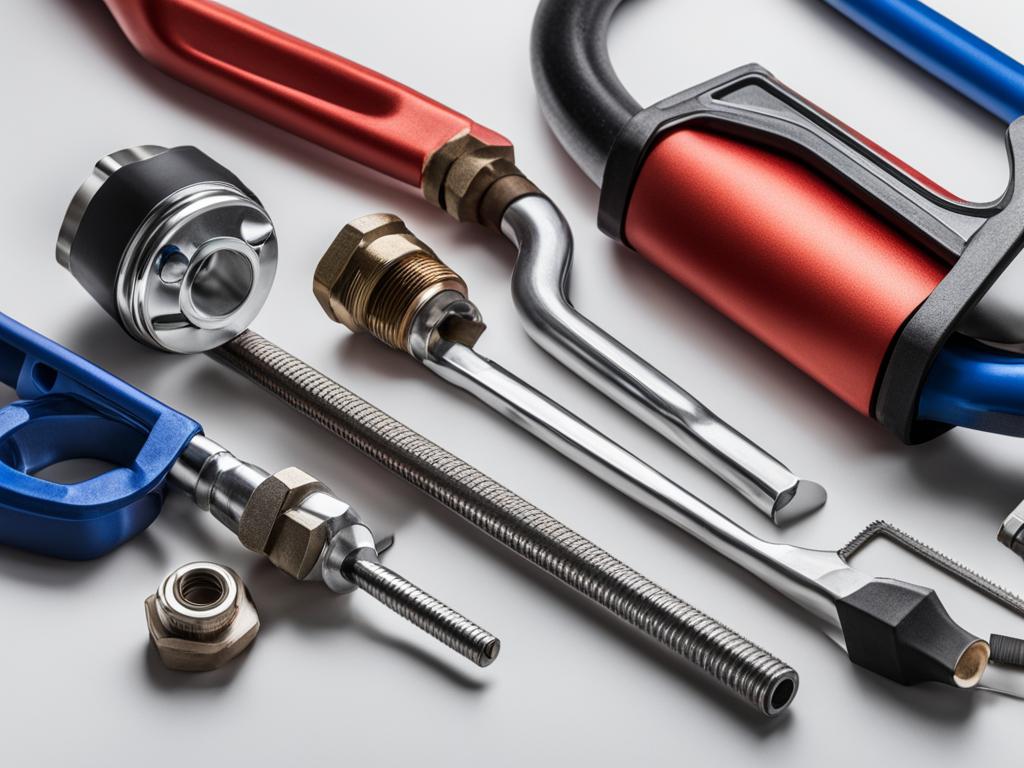
Understanding the Whistling Toilet Problem
A whistling toilet can be a frustrating and perplexing issue for homeowners. Understanding the causes and troubleshooting methods can help you tackle this problem effectively. In this section, we will delve into the common causes of a whistling toilet and discuss potential solutions.
One of the primary causes of a whistling toilet is a deteriorated fill valve gasket or worn-out parts. Over time, these components can become damaged or worn, causing vibrations that transfer to the armature and ball. This transfer of vibrations results in a high-pitched whistle that can be quite bothersome.
In order to address the whistling noise, it is crucial to replace the fill valve or install a new gasket. By doing so, you can eliminate the vibrations and restore the proper functioning of your toilet. Let’s take a closer look at how you can fix a whistling toilet by replacing the fill valve.
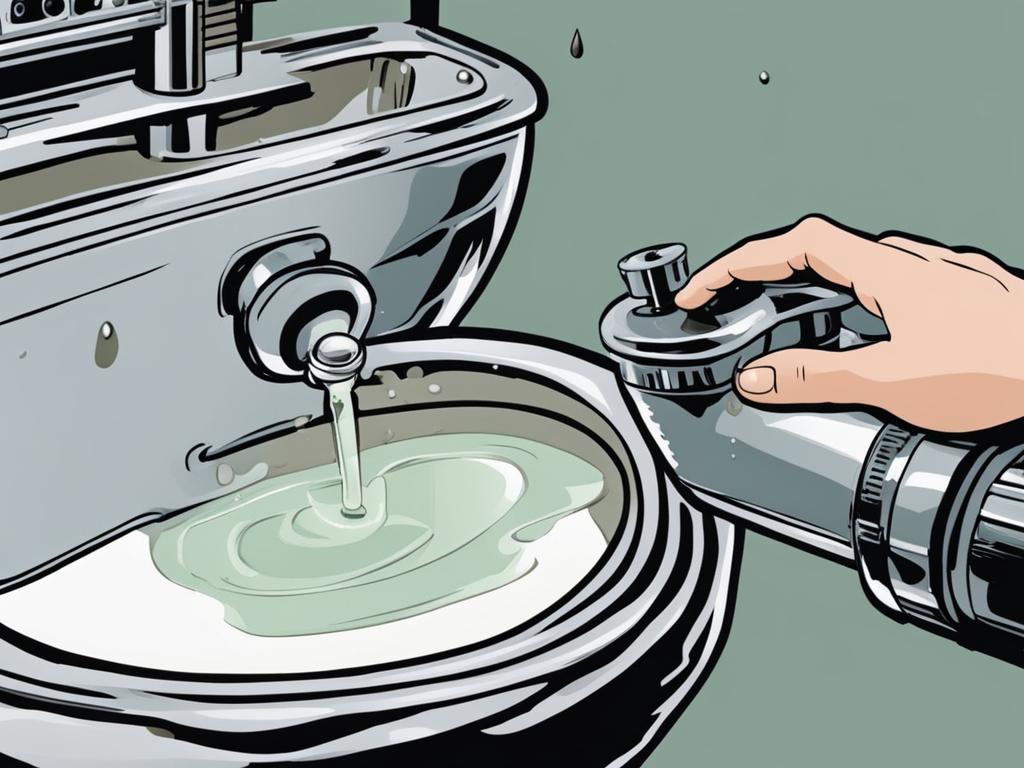
Fixing a Whistling Toilet with Replacement Fill Valve
Replacing the fill valve is a straightforward process that can be done by following a few simple steps:
- Shut off the water supply to the toilet and empty the tank.
- Locate the fill valve at the bottom of the tank and unscrew it.
- Install the new fill valve and adjust it to the appropriate water level.
- Tighten the fill valve securely to ensure proper functioning.
By replacing the fill valve, you can effectively stop the whistling sound and prevent any further issues with your toilet. It is important to choose a fill valve made of all-plastic parts, as these are less likely to cause whistling.
Remember, if you are unsure about fixing the whistling toilet yourself or if the issue persists after attempting DIY repairs, it is always advisable to seek the services of a professional plumber. They have the expertise to diagnose the problem and provide professional solutions to ensure a properly functioning toilet.
Fixing a Whistling Toilet with Replacement Fill Valve
If you’re tired of the annoying whistling sound coming from your toilet, replacing the fill valve can be an effective solution. New fill valves made of all-plastic parts are less likely to cause whistling, ensuring a quieter and more efficient toilet. Follow these simple steps to replace the fill valve and put an end to the whistling:
- Begin by shutting off the water supply to the toilet. Look for the valve located on the wall behind or near the toilet and turn it clockwise to close it.
- Now, empty the tank by flushing the toilet and holding down the handle until all the water has drained.
- Locate the old fill valve at the bottom of the tank and use a wrench or pliers to unscrew it counterclockwise. Carefully remove the old valve and dispose of it.
- Take the new fill valve and place it into the hole at the bottom of the tank. Make sure it is positioned correctly and secure it in place by tightening it clockwise with the wrench or pliers.
- Adjust the new fill valve to the appropriate level. Most fill valves have adjustable float arms that can be raised or lowered to control the water level in the tank. Consult the manufacturer’s instructions for specific guidance on adjusting the valve.
- Once the fill valve is installed and adjusted, turn the water supply back on by turning the valve counterclockwise. Allow the tank to fill with water and check for any leaks around the fill valve or other connections.
- Finally, flush the toilet a few times to ensure proper functioning and to verify that the whistling noise has been eliminated.
By replacing the fill valve with a new one, you can permanently fix the whistling issue and enjoy a quieter and more peaceful bathroom experience.
Replacing the fill valve is a relatively simple DIY task that can save you money on plumbing repairs. Just remember to shut off the water supply, empty the tank, unscrew the old valve, install the new one, adjust the water level, and turn the water supply back on. It’s a straightforward process that can make a big difference in eliminating the whistling sound.” – [Your Name], Professional Plumber
Table: Comparison of Plastic Fill Valves and Metal Ballcock Valves
| Features | Plastic Fill Valve | Metal Ballcock Valve |
|---|---|---|
| Noise Level | Less likely to cause whistling noises | Can produce vibrations and whistling noises |
| Cost | Affordable | Slightly more expensive |
| Durability | Durable and resistant to corrosion | Prone to corrosion and wear over time |
| Installation | Easy to install with basic tools | May require professional installation |
| Maintenance | Low maintenance, usually only requiring occasional cleaning | May require more frequent maintenance and repairs |
As shown in the table above, replacing a metal ballcock valve with a plastic fill valve can significantly reduce the chances of experiencing whistling noises in your toilet. Plastic fill valves are affordable, durable, and easy to install, making them an excellent choice for resolving whistling toilet issues.
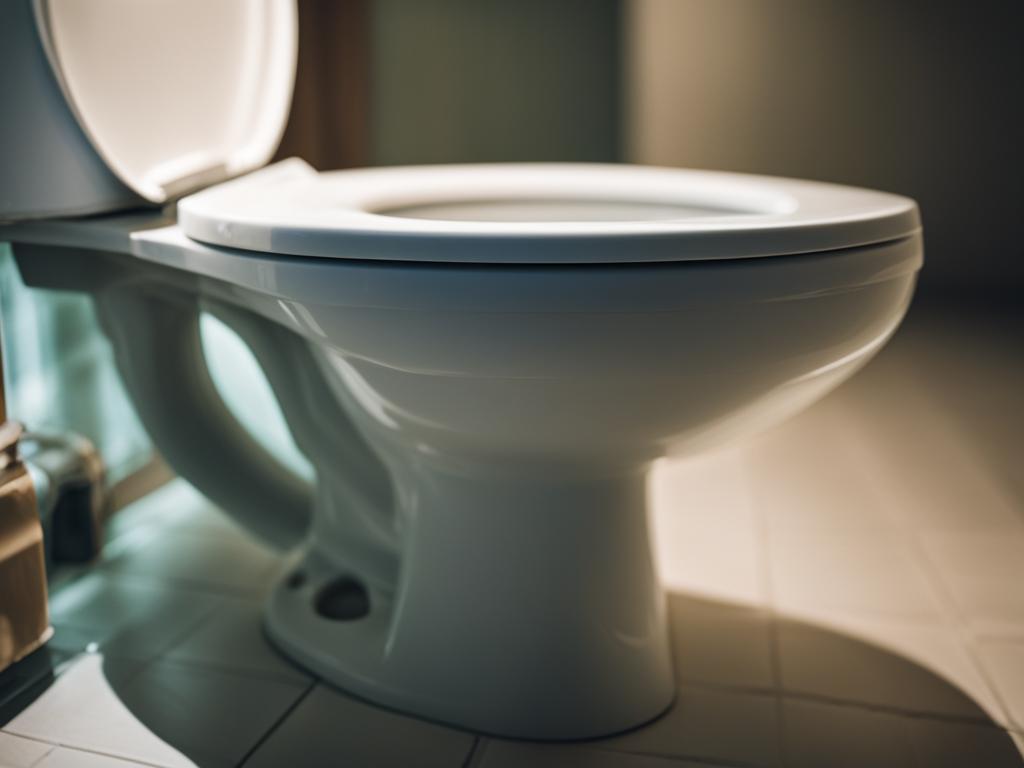
Conclusion
Don’t ignore a whistling toilet, as it can be a sign of an underlying issue that needs to be addressed. The most common cause of a whistling toilet is a deteriorated fill valve, which can be easily replaced. Regular maintenance and prompt repairs can prevent further damage and ensure the proper functioning of your toilet. If DIY repairs are not successful, don’t hesitate to contact a professional plumber for expert assistance.
FAQ
Why does my toilet whistle?
A whistling toilet is usually caused by a faulty fill valve or a faulty gasket in the ballcock. Over time, the fill valve can deteriorate, leading to the whistling sound.
What are the common causes of a whistling toilet?
The most common causes of a whistling toilet are a damaged or deteriorated fill valve and a faulty gasket in the ballcock. These issues can cause vibrations and result in a whistling noise.
How can I fix a whistling toilet myself?
The most common fix for a whistling toilet is to replace the fill valve. This can be done by unscrewing the old fill valve and installing a new one. If the issue persists or if you are unsure, it is recommended to contact a professional plumber for assistance.
How can I prevent my toilet from whistling?
To prevent a toilet from whistling, regularly clean the fill valve and replace the gasket inside it. Consider replacing a metal ballcock valve with a plastic one, as plastic valves are less likely to cause whistling.
What happens if I ignore a whistling toilet?
Ignoring a whistling toilet can lead to an overflowing toilet and significant water damage to your bathroom and home. It is important to address the issue promptly to prevent further damage.
Is it necessary to hire a professional plumber to fix a whistling toilet?
While many homeowners can fix a whistling toilet themselves, it is recommended to seek the assistance of a professional plumber if the problem persists or if you are unsure. They can diagnose any underlying issues and provide expert solutions.
How does a toilet fill valve work?
The toilet fill valve is responsible for regulating the water level in the toilet tank. It consists of a float that rises and falls with the water level. When the float is low, the valve opens to allow water to enter the tank. As the water reaches the desired level, the valve closes to prevent any more water from entering.
What causes a toilet to whistle after flushing?
The most common cause of a whistling toilet after flushing is a deteriorated fill valve. Over time, the parts of the valve can deteriorate, leading to the whistling sound.
How can I troubleshoot a whistling toilet?
Start by checking the water supply valve to ensure it is fully open. If the whistling persists, remove the toilet tank’s cover and inspect the fill valve for any debris. Clean off any deposits and flush the toilet to see if the whistling sound stops. If not, it may be necessary to replace the fill valve.
How can I fix a whistling toilet myself?
To fix a whistling toilet, start by shutting off the water supply and emptying the tank. Unscrew the old fill valve from the bottom of the tank and replace it with a new one. Adjust the new fill valve to the appropriate level and secure it in place. This simple fix can eliminate the whistling sound.
Why is it important to address a whistling toilet promptly?
Ignoring a whistling toilet can lead to higher water usage, increased utility bills, and even an overflowing toilet. Taking prompt action to repair the whistling toilet can help prevent further damage and ensure the proper functioning of your toilet.
Should I hire a professional plumber to fix a whistling toilet?
While many homeowners can fix a whistling toilet themselves, it is always recommended to seek the assistance of a professional plumber if the issue persists or if you are unsure. They have the knowledge and expertise to diagnose and repair any underlying issues causing the whistling.
What is the cause of a whistling toilet?
A whistling toilet can occur when the fill valve gasket or parts are old and worn, causing vibrations. These vibrations transfer to the armature and ball, resulting in the high-pitched sound.
How can I permanently stop the whistling sound from my toilet?
To permanently stop the whistling sound, consider replacing the fill valve with a new one. New fill valves made of all-plastic parts are less likely to cause whistling.
Why is it important not to ignore a whistling toilet?
Ignoring a whistling toilet can be a sign of an underlying issue that needs to be addressed. The noise may seem insignificant at first, but it can worsen over time and lead to an overflowing toilet. It is crucial to address the issue as soon as it is noticed to prevent further damage.
How can a professional plumber help with a whistling toilet?
A professional plumber can diagnose the cause of the whistling and provide expert solutions. They have the knowledge and expertise to repair any underlying issues causing the whistling, ensuring that your toilet functions properly.
What is the function of a toilet fill valve?
The toilet fill valve is responsible for regulating the water level in the toilet tank after each flush. It opens to allow water to enter the tank and closes to prevent any more water from entering once the desired level is reached.
What causes a whistling toilet after flushing?
The most common cause of a whistling toilet after flushing is a deteriorated fill valve. Over time, the parts of the valve can deteriorate, resulting in the whistling sound.
How can I troubleshoot a whistling toilet?
To troubleshoot a whistling toilet, first check the water supply valve and ensure it is fully open. If the whistling persists, inspect the fill valve for debris and clean it off. If the issue continues, it may be necessary to replace the fill valve.
How can I fix a whistling toilet myself?
To fix a whistling toilet yourself, start by shutting off the water supply and emptying the tank. Unscrew the old fill valve and replace it with a new one. Adjust the new fill valve to the appropriate level and secure it in place. This should eliminate the whistling noise.
Why is it important to promptly address a whistling toilet?
Promptly addressing a whistling toilet is important because the sound can be a sign of an underlying issue. Ignoring the problem can lead to higher water usage, increased utility bills, and even an overflowing toilet. Taking prompt action can prevent further damage.
How can professional plumbing services help with a whistling toilet?
Professional plumbers have the knowledge and expertise to diagnose and repair any underlying issues causing a whistling toilet. They can provide expert solutions and ensure that your toilet is properly repaired.
What causes a whistling toilet?
A whistling toilet is typically caused by a faulty fill valve or a faulty gasket in the ballcock. Over time, these parts can deteriorate and result in vibrations and a whistling noise.
How can I fix a whistling toilet with a replacement fill valve?
To fix a whistling toilet with a replacement fill valve, shut off the water supply and empty the tank. Unscrew the old fill valve and install the new one, adjusting it to the appropriate level. This should resolve the whistling sound and ensure proper functioning of your toilet.

